Best Dog Food for Great Danes
Best Dog Food for a Great Dane
Hey there, fellow humans! It’s me, your friendly neighborhood Great Dane, Yeti, and I need to have a serious talk with you about my dinner bowl.
When choosing my kibble, look for options packed with good stuff like chicken or beef – I need that protein to make up about 20-30% of my food. Trust me, my muscles didn’t get this magnificent by accident!
Don’t forget about the fats either – around 8-15% keeps my coat looking fabulous and gives me energy to knock over your coffee table (sorry, not sorry). And please, PLEASE skip the grains! My giant belly is surprisingly sensitive, and those grains make me feel all rumbly and uncomfortable. Please stick to the easy-to-digest carbs that won’t turn me into a gassy mess.
Here’s the vital part – don’t dump all my food in one giant bowl and call it a day. I know it’s tempting, especially since I’m huge, but try splitting your meals into two or three smaller ones. This keeps me from inhaling everything like a furry vacuum cleaner and helps prevent my stomach from doing scary flips.
Also, watch those portion sizes! I may give you my best puppy dog eyes (they’re pretty impressive at this size), but keeping me at a healthy weight means I can continue to be your lovable giant for years to come.
There’s more to nutrition than this, but this covers the basics of keeping this big guy happy and healthy!
Nutritional Needs of Great Danes
First things first – I’m HUGE! I mean, I can probably look you in the eye while you’re standing up. As one of the largest dog breeds, I require special food tailored to my enormous appetite and high energy levels. When I get the zoomies in the backyard, I’m burning serious calories!
Let me tell you about protein – it’s my best friend! I need lots of high-quality protein to keep these massive muscles strong and healthy. Without enough protein, I’d be like a deflated balloon instead of the magnificent, gentle giant I am today.
And water? Oh boy, do I drink a lot of water! I go through my water bowl faster than you go through your morning coffee. My humans better keep that bowl filled because staying hydrated is no joke when you’re my size. I need way more water than those tiny dogs who think they’re tough.
Here’s something important – my humans have to watch my weight like hawks. Eating too much food will make me chunky, which isn’t good for my joints. Too little and I’ll be hangry all the time. Nobody wants a hangry Great Dane! Additionally, my diet needs to include balanced nutrition to support my overall health and prevent any serious issues.
Ideal Food Composition for Great Danes
I have some pretty specific needs when it comes to my food, and I’m here to set the record straight.
First things first – I need the good stuff when it comes to protein. We’re talking 20-30% of my food should be high-quality protein. Think of it as the premium fuel for this magnificent giant body of mine. I’m not asking for a five-star steak dinner every night (though I wouldn’t complain), but cheap protein just won’t cut it for a dog of my stature.
Now, regarding fats, I need a food with about 8-15% fat content. I know what you’re thinking: “But you’re already huge!” Trust me, these aren’t the kind of fats that’ll make me look bad in my collar photos. These healthy fats keep my coat shiny and give me energy to chase squirrels in the backyard (even though we both know I’ll never catch one).
Don’t forget about carbs either! I need digestible carbohydrates to keep this big engine running. Think of them as the kindling that keeps my energy fire burning throughout the day.
Here’s where it gets vital – my joints work overtime carrying around all this greatness. Tossing in some omega fatty acids and glucosamine supplements is like giving my joints a daily spa treatment. Trust me, future me will thank you when I’m still bounding around like a puppy instead of creaking like an old door. Additionally, maintaining a healthy weight is crucial for mitigating the risks of conditions like hip dysplasia, so proper nutrition is essential.
The bottom line? Feed me right, and I’ll be your energetic, healthy giant companion for years to come. Feed me wrong, and you’ll have a grumpy Great Dane on your hands – and nobody wants that!
Feeding Frequency and Portion Control
Trust me, I learned this the hard way when I tried to inhale my entire dinner in thirty seconds. Let’s just say it didn’t end well for anyone involved.
Here’s the scoop on keeping this big guy happy and healthy: split my food into two or three meals throughout the day. I know, I know – it sounds like torture to wait between meals when you’re my size. But here’s the thing: eating smaller meals helps prevent something called bloat, which is not as fun as it sounds.
Plus, my tummy digests food better when I’m not trying to stuff a week’s worth of kibble down in one go.
Timing is everything, people! I’m like a furry alarm clock – feed me at the exact times every day, and my body will thank you for it. My metabolism loves routine almost as much as I love belly rubs.
As for how much food to give me, check those feeding guides on the bag, but remember – I might need more or less depending on whether I’m a couch potato or if I’ve been chasing squirrels all day. It’s also essential to ensure that my diet has a balanced calcium and phosphorus ratio to support my bone health.
Keep an eye on my waistline (yes, I’ve one somewhere under all this fur), and adjust accordingly. A healthy, happy Great Dane is the ultimate Great Dane!
Health Considerations Related to Diet
My tummy is way more sensitive than you might think! Some foods make me feel unwell or cause me to develop symptoms, so please check what’s in my bowl before you fill it up.
Here’s the thing that might shock you – I can get chunky! I know, I know, with these long legs, you’d think I’d stay skinny forever.
But trust me, when I put on extra weight, my joints start creaking like an old door, and my heart has to work overtime. Nobody wants a wheezing Great Dane!
So here’s what I’m asking for: keep an eye on how much you’re scooping into my bowl. I’ve zero self-control when it comes to food (have you seen me inhale a bowl of kibble in 30 seconds?), so you’ll have to be the responsible one here.
What I really need is the good stuff – tasty protein to keep my muscles strong, healthy fats to make my coat shiny, and just the right amount of carbs for energy. It’s also essential to avoid high-protein puppy foods that can lead to skeletal disorders in growing puppies.
When you get this combo right, I’ll be bouncing around like a puppy well into my golden years!
Take care of my diet, and I’ll keep being your lovable, slobbering giant for years to come!
Recommended Dog Food Types and Ingredients
Now, I know what you’re thinking. “Wow, this dog is huge! He must eat everything!” Well, you’re half right. I’m quite large (okay, I’m huge), but my tummy is quite particular about what goes into it.
First things first – let’s talk about grain-free food. I know it sounds fancy, but trust me, my belly thanks my humans every day for picking the good stuff. Grains can make my stomach feel weird and bloated, similar to how it feels after eating too much pizza. Nobody wants a gassy Great Dane walking around the house!
The protein thing is enormous for us big dogs. I mean, look at me! All this muscle doesn’t build itself. I need good protein sources, such as chicken, beef, or fish, to keep me strong and help me grow into the gentle giant I’m meant to be. High-biological-value proteins are essential for my growth and development.
Without enough protein, I’d probably fall over trying to reach my food bowl – and that isn’t very comfortable when you’re my size.
Don’t forget about those healthy fats either! They keep my coat all shiny and give me energy to zoom around the yard (yes, we Great Danes can run pretty fast – surprise!). Plus, they help my brain stay sharp so I can figure out new ways to fit on the couch.
When my humans pick the right food with all these good ingredients, I feel amazing. I can play longer, my coat looks like I just came from a doggy spa, and my stomach stays happy.
Trust me, keeping a Great Dane’s digestive system happy is suitable for everyone in the house!
Grain-Free Formulations
My human keeps debating whether I need grain-free food or not. Honestly, I’m just happy when there’s food in my bowl! But I’ve noticed some pretty cool things about grain-free kibble that make my tail wag.
First off, this stuff usually has way more protein and fat, which is perfect for a big guy like me. I need lots of energy to chase squirrels and take up the entire couch (it’s my job, okay?). The extra protein helps keep my muscles strong, allowing me to maintain my impressive size and intimidate the mailman.
My human also says grain-free food might help if I’ve food allergies. I don’t really understand allergies, but if it means less itchy skin and more belly rubs, I’m all for it!
But here’s the thing – my human got worried about some potential heart problems associated with certain grain-free foods. That scared me a little because I need my heart to keep pumping so I can continue my important work of being adorable and knocking things over with my tail.
The bottom line? My human and I decided to be really picky about which grain-free food we choose. We make sure it has everything a growing giant like me needs to stay healthy and happy!
Essential Protein Sources
Essential Protein Sources
We Great Danes require high-quality protein. I’m referring to high-quality meats, such as lamb. These aren’t just tasty (and boy, are they delicious!), but they give us all the amino acids we need to keep our muscles strong.
When you’re as big as me, you need all the muscle support you can get!
Here’s a tip from one dog to another: always check that meat is the first ingredient on the food label. If it’s not, then it’s not worth our time. We deserve the best, and that means protein should be the star of the show, not some filler ingredient.
Don’t forget about fish meal either! I know it might sound weird to some of you land-loving pups, but fish meal is packed with Omega-3 fatty acids. These help keep our coats shiny and our skin healthy.
Plus, let’s be honest – looking good is essential when you’re as magnificent as a Great Dane!
With the right protein sources, we can stay strong, healthy, and ready for whatever adventures come our way. Whether that’s a long walk or an epic nap session, good protein keeps us going strong! Balanced diets support our overall health and vitality, enabling us to enjoy life to the fullest.
Healthy Fat Inclusion
Woof! Let me tell you about something super important for us Great Danes – healthy fats! I know what you’re thinking: “But don’t you already have enough fat, you giant goofball?” Trust me, we need the RIGHT kind of fats to keep our massive bodies running smoothly.
Think of healthy fats as our secret fuel. They give us energy to knock over more furniture (sorry, humans!), help us absorb all those vitamins you sneak into our food, and keep our coats so shiny that we look like doggy supermodels. Well, really tall, drooling supermodels.
The best fats for us come from fish oil, flaxseed, and chicken fat. Fish oil makes us smell interesting to other dogs, flaxseed sounds fancy (which we Great Danes are), and chicken fat… well, anything with “chicken” in the name gets two paws up from me!
Here’s the tricky part, though – balance is everything. Too much fat and we become Great Danes who can’t fit through doorways. Too little fat and our gorgeous coats start looking like we stuck our paws in electrical sockets. Neither look is good on us. Ensuring our diet has adequate fat content is crucial for supporting our overall health and development.
Feeding Tips for Great Danes
Hey There, Fellow Dog Lovers! A Great Dane’s Guide to Dinner Time
Get Me on a Schedule (Please!)
Listen, I love routine almost as much as I love belly rubs. When my humans feed me at the exact times daily, my tummy stays happy, and I don’t get that scary bloat.
I thrive on routine, just like I thrive on belly rubs! Consistent meal times keep my tummy happy and bloat-free.
Plus, I can plan my nap schedule around meals – essential for a dog my size!
Homemade Food? Yes, Please!
Sometimes my humans get fancy and make my food from scratch. I’m not complaining! But they learned the hard way that I need more than just leftover chicken.
I need proteins (the good stuff), healthy fats (for my shiny coat), and carbs (for zoomies energy). A balanced meal makes this gentle giant very happy.
Size Matters – Even for Food
My humans use measuring cups now because, apparently, I was getting a little too fluffy around the middle.
Nobody wants a chunky Great Dane – it’s hard on these long legs of mine!
Final Thoughts
In conclusion, getting the right food is super essential for us Great Danes to stay healthy and happy! My human needs to pick food that’s just right for big dogs like me, feed me at the right times, and watch out for any health problems. Trust me, all us Great Danes are counting on our humans to figure this stuff out! When my human makes wise choices about my food, I can live longer and be the goofiest, tail-wagging giant they’ve ever seen. So come on, humans – let’s work together to keep us gentle giants well-fed and feeling awesome!
References
- https://americannaturalpremium.com/breed-guide/great-dane-dietary-needs-and-feeding-guide/
- https://www.prodograw.com/raw-feeding-guide/great-dane-feeding-guide/
- https://www.dogster.com/dog-nutrition/how-much-food-does-a-great-dane-need
- http://www.greatdanerescue.com.au/Docs/diet_section.pdf
- https://vcahospitals.com/know-your-pet/nutritional-requirements-of-large-and-giant-breed-puppies
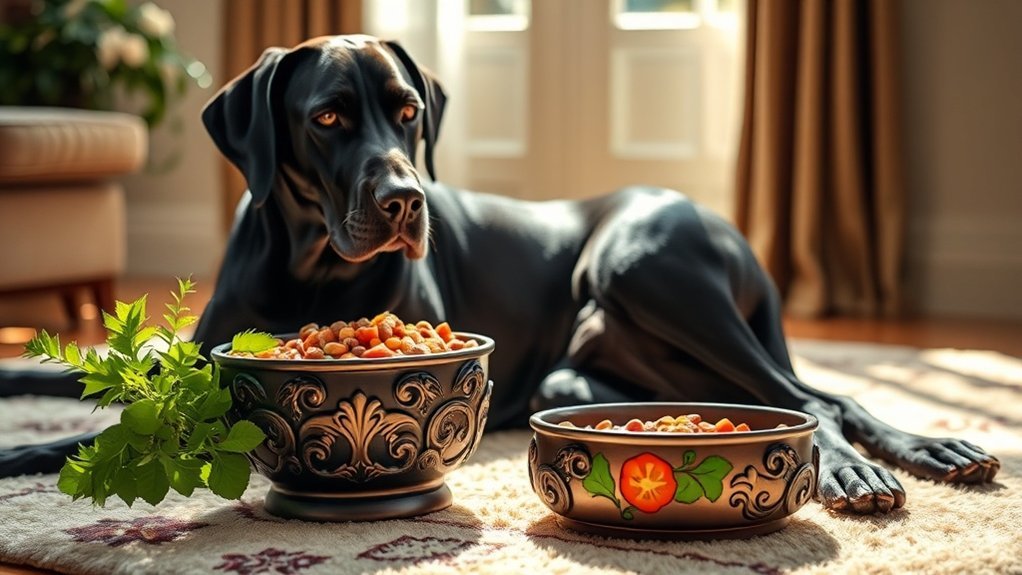


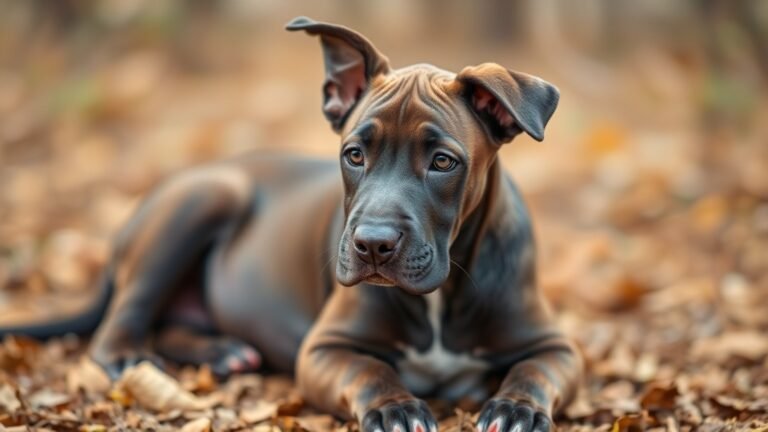
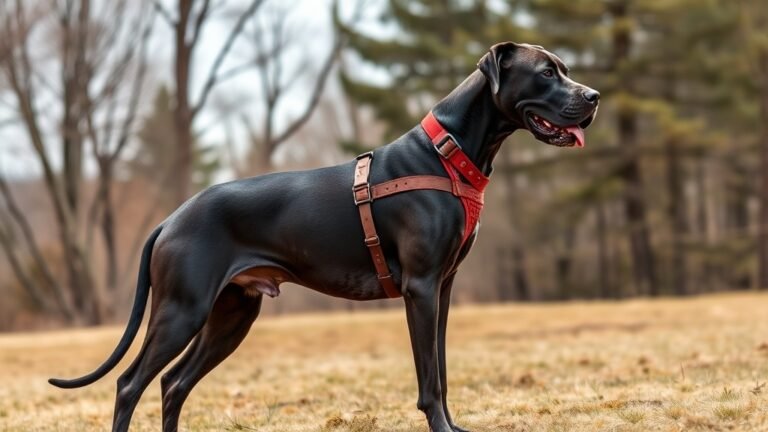
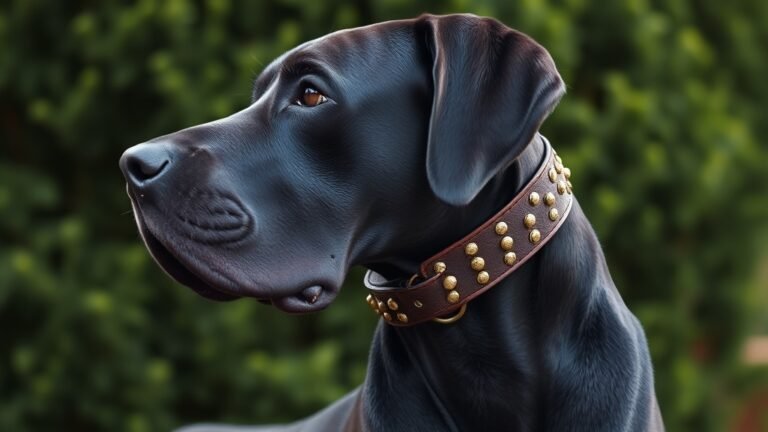
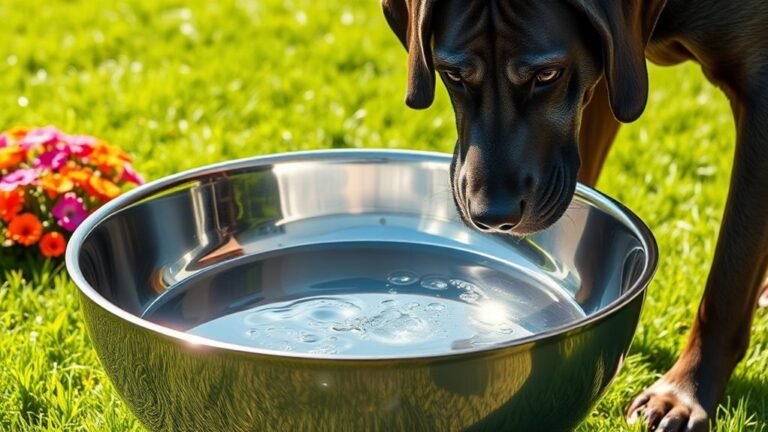
24 Comments